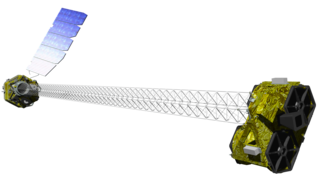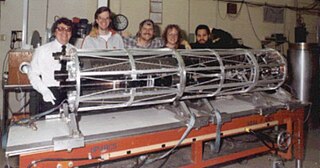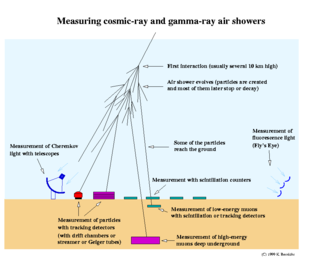Gallery
- Skylab S-54 instrument, an X-ray telescope
- Chandra (AXAF) checks out a pulsar with its focusing X-ray optics
- NuStar's lens for focusing X-rays
- Wolter telescopes of Types I, II, and III
X-ray telescopes are designed to observe the x-ray region of the electromagnetic spectrum. X-rays from outer space cannot be observed from the ground due to absorption by the atmosphere, and so x-ray telescopes must be launched into orbit. Their mirrors require a very low angle of reflection (typically 10 arc-minutes to 2 degrees). [1] These are called glancing (or grazing) incidence mirrors. In 1952, Hans Wolter outlined three ways a telescope could be built using only this kind of mirror. [2] [3]
This list contains space-borne observatories as well as X-ray instruments as part of a larger mission, both past, present and in the proposal stage.
| Name | Launch | Notes |
|---|---|---|
| Ariel 5 | 1974 | |
| Ariel 6 | 1979 | |
| ASCA | 1993 | |
| ATHENA | 2031 | Under development |
| AGILE | 2007 | |
| Apollo Telescope Mount | 1973 | Part of Skylab, operated 1973-1974 |
| Arcus | — | Proposal, not selected for launch in 2019 |
| ALEXIS | 1993 | |
| ANS | 1974 | |
| Astrosat | 2015 | |
| BeppoSAX | 1996 | |
| BBXRT | 1990 | |
| Compton Gamma Ray Observatory | 1991 | |
| Chandra X-ray Observatory | 1999 | |
| Constellation-X Observatory | — | 2008 proposal, merged into the International X-ray Observatory proposal |
| Copernicus | 1972 | |
| Cos-B | 1975 | |
| DXS | 1993 | |
| Einstein Observatory | 1978 | originally HEAO-2 |
| Einstein Probe | 2024 | Under development |
| EP-WXT | 2022 | |
| eROSITA | 2019 | |
| EXOSAT | 1983 | |
| Fermi | 2008 | |
| Ginga | 1987 | |
| Granat | 1989 | |
| Gravity and Extreme Magnetism | — | 2012 proposal |
| Hakucho | 1979 | |
| Hard X-ray Modulation Telescope | 2017 | (HXMT) also known as Insight (Chinese :慧眼) |
| HEAO-1 | 1977 | |
| HEAO 3 | 1979 | |
| High Energy Transient Explorer | 1996 | |
| Hinode | 2006 | |
| Hinotori | 1981 | Originally ASTRO-A |
| Hitomi | 2016 | Originally ASTRO-H |
| IXPE | 2021 | |
| INTEGRAL | 2002 | |
| International X-ray Observatory | — | 2012 proposal, now part of ATHENA |
| LOFT | — | Proposal |
| Lynx | 2036 | Study/proposal |
| Max Valier Sat | 2017 | |
| MAXI | 2009 | |
| Neil Gehrels Swift Observatory | 2004 | Originally Swift Gamma-Ray Burst Mission [4] |
| NICER | 2017 | |
| NuSTAR | 2012 | |
| OAO-1 | 1966 | |
| ORBIS | — | Under development |
| OSO 7 | 1971 | |
| OSO 8 | 1975 | |
| RHESSI | 2002 | |
| ROSAT | 1990 | |
| RXTE | 1995 | |
| SAS-3 | 1975 | |
| SVOM | 2024 | Under development |
| Spektr-RG | 2019 | |
| Suzaku | 2005 | |
| Tenma | 1983 | |
| Uhuru | 1970 | |
| Vela | 1963 | |
| XRISM | 2023 | |
| XEUS | — | Proposal, merged into the International X-ray Observatory proposal, now part of the ATHENA proposal |
| XMM-Newton | 1999 | |
| XPoSat | 2023 | Planned, under development |
| Yohkoh | 1991 |
Sometimes X-Ray observations are made from a near-space environment on sounding rockets or high-altitude balloons.

X-ray astronomy is an observational branch of astronomy which deals with the study of X-ray observation and detection from astronomical objects. X-radiation is absorbed by the Earth's atmosphere, so instruments to detect X-rays must be taken to high altitude by balloons, sounding rockets, and satellites. X-ray astronomy uses a type of space telescope that can see x-ray radiation which standard optical telescopes, such as the Mauna Kea Observatories, cannot.

The George C. Marshall Space Flight Center (MSFC), located in Redstone Arsenal, Alabama, is the U.S. government's civilian rocketry and spacecraft propulsion research center. As the largest NASA center, MSFC's first mission was developing the Saturn launch vehicles for the Apollo program. Marshall has been the lead center for the Space Shuttle main propulsion and external tank; payloads and related crew training; International Space Station (ISS) design and assembly; computers, networks, and information management; and the Space Launch System. Located on the Redstone Arsenal near Huntsville, MSFC is named in honor of General of the Army George C. Marshall.

NASA's series of Great Observatories satellites are four large, powerful space-based astronomical telescopes launched between 1990 and 2003. They were built with different technology to examine specific wavelength/energy regions of the electromagnetic spectrum: gamma rays, X-rays, visible and ultraviolet light, and infrared light.
The Extreme ultraviolet Imaging Telescope (EIT) is an instrument on the SOHO spacecraft used to obtain high-resolution images of the solar corona in the ultraviolet range. The EIT instrument is sensitive to light of four different wavelengths: 17.1, 19.5, 28.4, and 30.4 nm, corresponding to light produced by highly ionized iron (XI)/(X), (XII), (XV), and helium (II), respectively. EIT is built as a single telescope with a quadrant structure to the entrance mirrors: each quadrant reflects a different colour of EUV light, and the wavelength to be observed is selected by a shutter that blocks light from all but the desired quadrant of the main telescope.

NuSTAR is a NASA space-based X-ray telescope that uses a conical approximation to a Wolter telescope to focus high energy X-rays from astrophysical sources, especially for nuclear spectroscopy, and operates in the range of 3 to 79 keV.
In optics, an image-forming optical system is a system capable of being used for imaging. The diameter of the aperture of the main objective is a common criterion for comparison among optical systems, such as large telescopes.

The Multi-spectral solar telescope array, or MSSTA, was a sounding rocket payload built by Professor A.B.C. Walker, Jr. at Stanford University in the 1990s to test EUV/XUV imaging of the Sun using normal incidence EUV-reflective multilayer optics. MSSTA contained a large number of individual telescopes, all trained on the Sun and all sensitive to slightly different wavelengths of ultraviolet light. Like all sounding rockets, MSSTA flew for approximately 14 minutes per mission, about 5 minutes of which were in space—just enough time to test a new technology or yield "first results" science. MSSTA is one of the last solar observing instruments to use photographic film rather than a digital camera system such as a CCD. MSSTA used film instead of a CCD in order to achieve the highest possible spatial resolution and to avoid the electronics difficulty presented by the large number of detectors that would have been required for its many telescopes.

An X-ray telescope (XRT) is a telescope that is designed to observe remote objects in the X-ray spectrum. In order to get above the Earth's atmosphere, which is opaque to X-rays, X-ray telescopes must be mounted on high altitude rockets, balloons or artificial satellites.
X-ray optics is the branch of optics that manipulates X-rays instead of visible light. It deals with focusing and other ways of manipulating the X-ray beams for research techniques such as X-ray crystallography, X-ray fluorescence, small-angle X-ray scattering, X-ray microscopy, X-ray phase-contrast imaging, and X-ray astronomy.

Hinode, formerly Solar-B, is a Japan Aerospace Exploration Agency Solar mission with United States and United Kingdom collaboration. It is the follow-up to the Yohkoh (Solar-A) mission and it was launched on the final flight of the M-V rocket from Uchinoura Space Center, Japan on 22 September 2006 at 21:36 UTC. Initial orbit was perigee height 280 km, apogee height 686 km, inclination 98.3 degrees. Then the satellite maneuvered to the quasi-circular Sun-synchronous orbit over the day/night terminator, which allows near-continuous observation of the Sun. On 28 October 2006, the probe's instruments captured their first images.

A telescope is a device used to observe distant objects by their emission, absorption, or reflection of electromagnetic radiation. Originally it was an optical instrument using lenses, curved mirrors, or a combination of both to observe distant objects – an optical telescope. Nowadays, the word "telescope" is defined as wide range of instruments capable of detecting different regions of the electromagnetic spectrum, and in some cases other types of detectors.

AstroSat is India's first dedicated multi-wavelength space telescope. It was launched on a PSLV-XL on 28 September 2015. With the success of this satellite, ISRO has proposed launching AstroSat-2 as a successor for AstroSat.
Hans Wolter was a German physicist who designed an aplanatic system of grazing incidence mirrors that satisfied the Abbe sine condition . Wolter showed such a system could be produced using a combination of a paraboloid with either a hyperboloid or ellipsoid secondary. The three simplest designs are outlined and are known as Wolter telescopes of types I, II and III.
Leon P. Van Speybroeck was an American astronomer who served as Telescope Scientist for the Chandra X-Ray Observatory, which was launched into space aboard the Space Shuttle Columbia in 1999. Van Speybroek designed the mirrors that made possible its spectacular X-ray images of nearby and remote celestial objects, including comets, exploding stars, jets of gas spewing from nearby black holes, and powerful quasars more than 10 billion light years from Earth. The data from Chandra prompted new discoveries about the evolution of stars and galaxies, the nature of the black holes, dark matter, and the shape and dimensions of the universe.

A Wolter telescope is a telescope for X-rays that only uses grazing incidence optics – mirrors that reflect X-rays at very shallow angles.

A cosmic-ray observatory is a scientific installation built to detect high-energy-particles coming from space called cosmic rays. This typically includes photons, electrons, protons, and some heavier nuclei, as well as antimatter particles. About 90% of cosmic rays are protons, 9% are alpha particles, and the remaining ~1% are other particles.

The history of X-ray astronomy begins in the 1920s, with interest in short wave communications for the U.S. Navy. This was soon followed by extensive study of the earth's ionosphere. By 1927, interest in the detection of X-ray and ultraviolet (UV) radiation at high altitudes inspired researchers to launch Goddard's rockets into the upper atmosphere to support theoretical studies and data gathering. The first successful rocket flight equipped with instrumentation able to detect solar ultraviolet radiation occurred in 1946. X-ray solar studies began in 1949. By 1973 a solar instrument package orbited on Skylab providing significant solar data.

The Focusing Optics X-ray Solar Imager, or FOXSI, is a sounding rocket payload built by UC Berkeley and led by Säm Krucker to test high energy grazing-incidence focusing optics paired with solid-state pixelated detectors to observe the Sun. FOXSI is composed of seven identical Wolter-I telescope modules, as well as Silicon and Cadmium Telluride strip detectors originally developed for the HXT telescope on the Japanese Hitomi mission. The FOXSI payload flew two times, most recently in 2014 and previously in 2012. Like most sounding rockets, FOXSI flew for approximately 15 minutes per mission and observed the Sun for about 5 minutes while in space. During its first flight, FOXSI successfully imaged a solar microflare in the hard x-ray band for the first time.

The Lynx X-ray Observatory (Lynx) is a NASA-funded Large Mission Concept Study commissioned as part of the National Academy of Sciences 2020 Astronomy and Astrophysics Decadal Survey. The concept study phase is complete as of August 2019, and the Lynx final report has been submitted to the Decadal Survey for prioritization. If launched, Lynx would be the most powerful X-ray astronomy observatory constructed to date, enabling order-of-magnitude advances in capability over the current Chandra X-ray Observatory and XMM-Newton space telescopes.

High-energy replicated optics (HERO) is a high-altitude balloon-borne x-ray telescope based at the Marshall Space Flight Center. Its mirrors are conical approximations to Wolter type 1 geometry. The proving flight, at least, used a high-pressure gas scintillation proportional counter with relatively low spatial resolution.